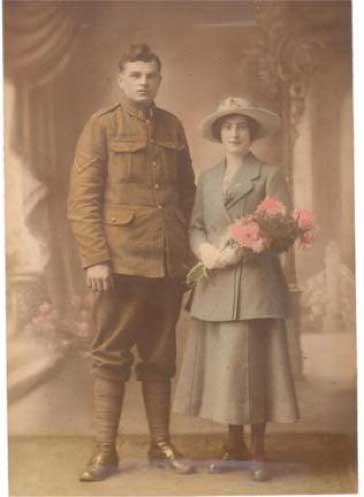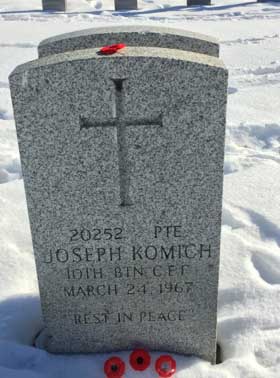


I have a document that shows the history of my father’s family back to something like the early 1500’s. I’m very thankful that someone else took on that task – can you imagine how long it would take to weed through a world of Taylors?
My mom’s side of the family is a bit more mysterious and she never really spoke about her parents or their families. All I knew was that she idolized her father and hated her mother. Oh, and I also had names. That was about it.
My grandfather died only a few months before I was born and my grandmother died in the mid 70’s. I vaguely remember meeting her once, but I couldn’t tell you much about it.
About a year or so before my mom died, I decided to research her father. His name was Joseph Komich, he was from Russia and he fought in WWI. That’s what I had to go on. I typed his name into the Google and lo and behold – I found his attestation papers available online through the Government of Canada.
I remember waiting for the file to load so that I could finally have a glimpse into this man, who according to family folklore loved his vodka, said, “Ay yi yi!” over and over again and had quite the presence about him (this information was gleaned from my father, who used to smuggle vodka for my grandfather in trunks while he was in the RCAF).
There he was – in all his military glory. Here was a piece of my own family history – and what an amazing piece it was to read. It detailed his entire military history from start to finish.
I remember showing my mom the document and she was absolutely beside herself. I helped her to decipher some of it, and she was thrilled to hear about his life and what it was like for him during WWI. Her favourite parts might have been the numerous times he was put on KP duty for either being ‘absent without leave’ or ‘drunk and disorderly in public’.
Over the years, I’ve continued dabbling with trying to piece things together and have managed to find the odd tidbit here and there. Last year, right before Remembrance Day (and the 100th Anniversary of Vimy) I found out that he had fought at Vimy and was wounded shortly thereafter at Arleux-en-Gohelle, (the Arleux Loop, for you WWI buffs). While his attestation papers gave me a general idea as to where he was and when he was there, they didn’t contain his every movement. I was gob smacked. My grandfather fought at Vimy. I found the actual diary of the day he was wounded and it was fascinating. I remember getting quite teary eyed – both from pride and from the fact that I never had the opportunity to meet him.
With November 11 right around the corner, our provincial government will be holding events celebrating the signing of the Armistice. I am blessed to have a job where I am involved in meetings to discuss these types of events. When I mentioned my grandfather and gave a bit of his history, I was asked if I would provide his picture and the information I had to include in the provincial events for Armistice/Remembrance Day.
After 100 years, I get to tell the story of my grandfather and his life during WWI! I hope this makes you proud, granddad. I know I am proud to be your granddaughter.
(Note: Please excuse any inaccurate military references; I am unsure of the proper verbiage to be used in some instances).
My grandfather, Joseph Komich, immigrated to Canada from Russia in the early 1900’s, lived in the southern part of Alberta and was a member of the 103rd Regiment (Calgary Rifles). On September 28, 1914, he arrived in Valcartier, Quebec as a member of the Canadian Expeditionary Force.
(taken from Calgaryhighlanders.com/history/103rd): Calgary’s first battalion was the Tenth Battalion; formed in Valcartier in September 1914, 846 men were provided by the 103rd Regiment (with 665 more coming from Manitoba’s 106th Winnipeg Light Infantry. The battalion was one of the last units of the initial contingent of the CEF to be formed, and recruits were drawn from a number of sources. The unit went on to fight as part of the First Canadian Division in every major Canadian engagement of the war. Recruits for the battalion were drawn from all over Canada, but the majority came from Alberta throughout the war, and its ’home’ was considered to be Calgary.
Granddad’s attestation papers indicated that he was an interpreter by trade (I’m assuming Russian/English).
On September 30, 1914, Granddad sailed to England. Then, on February 2 of 1915, he was sent to France. I am unsure of his military action in France before the Battle of Vimy. He fought at Vimy and from there members of the 10th Battalion went to Arleux-en-Gohelle (also known as the Arleux Loop) arriving in the area on or around April 28, 1917. The Arleux Loop had been especially troublesome for the Germans. Hand to hand combat broke out with the Canadians coming out on top, even though they were completely outnumbered. Skirmish after skirmish took place and on April 29, the German commander of the 111th Division admitted that the village was lost. The casualties were heavy – in two days 1,255 men were killed with numerous others wounded.
My grandfather was shot in both legs during the Battle of Arleux on April 28, 1917. He was operated on at the No. 3 Canadian General Hospital in Boulogne, France and from there was transferred to the 2nd Western General Hospital in Manchester, England. On September 10, 1917 he was transferred to Victoria Hospital in Stretford, England. He remained there until November of 1917 and was then transferred to a Canadian Convalescent Hospital in Epsom, England.
I believe it was during his stay at the Victoria Hospital in Stretford that he met his future wife. Myrtle Gerrard was his nurse and they married in early 1918. Only in the past couple of days have I found out that her brother, Benjamin Lincoln Gerrard, was in the hospital at the same time recovering from injuries sustained at Amiens, so I believe that he might have been the matchmaker. Myrtle was from a large family in the Cheshire area.
My grandfather never fully recovered properly. He was discharged (demobilized) on December 14, 1918. He and his new bride sailed back to Canada, where they landed at the base in Esquimalt, BC on January 3, 1919.
Granddad was given four medals during his service – the 1914/15 Star, the British War Medal, the Victory Medal and the one that was very special to him – the Cross of St. George, 4th Class (Russia). From what I was told, he rescued his woundedcommanding officer from a battlefield. Sadly, the medals were stolen in the mid 1970’s and have never been recovered. Just before my mom died, I had a replica of the Cross of St. George made for her.
My grandparents settled in Southern Alberta in a small town called Cheadle, which is just outside of Strathmore. My grandfather was instrumental in setting up the town and worked for the Canadian Pacific Railway.
They had 3 children, Olga (Larson), Elizabeth (Taylor) – my mother, and Donald Komich. All of them have passed away.
Joseph Komich died in Calgary, Alberta at the age of 82. He is interred in the military section of Burnsland Cemetery in Calgary. Myrtle Komich passed away in 1975.
Last year on Remembrance Day, my sister, brother in law and I made the trek down to Calgary to attend their Remembrance Day ceremonies and to pay respect to my grandfather. It was only the second time I’ve visited his grave.